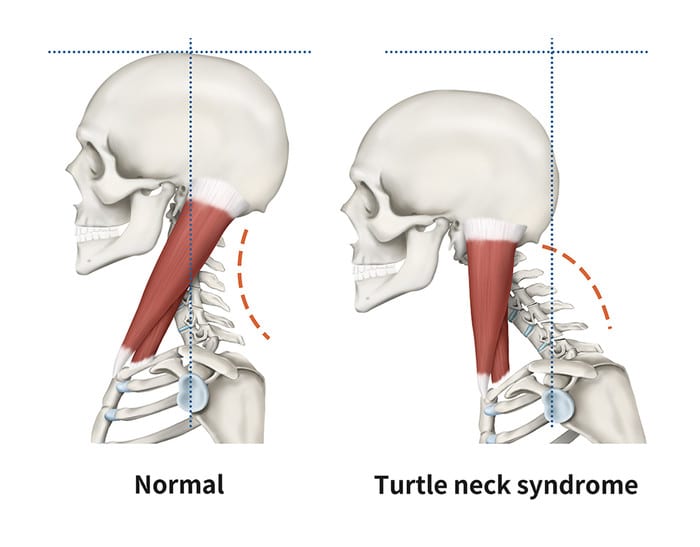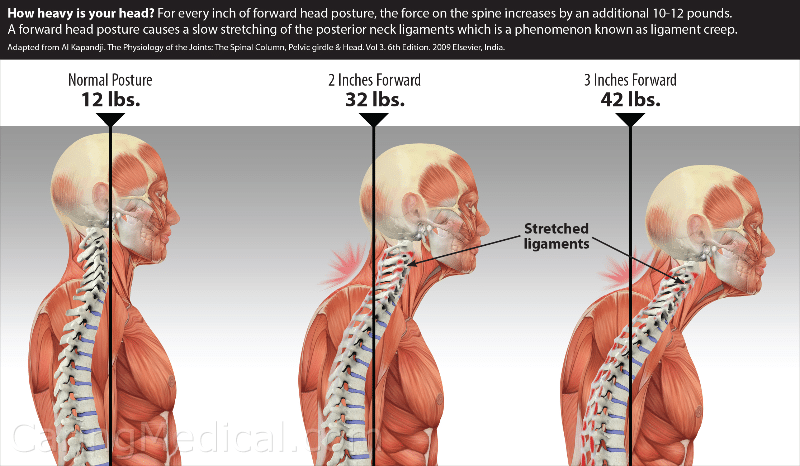In today’s digital world, many people unknowingly adopt poor posture while using mobile phones or working long hours at desks. This can lead to a common yet often ignored condition known as Turtle Neck Syndrome, also referred to as Forward Head Posture or Text Neck. This postural problem can cause chronic neck pain, stiffness, and even long-term spinal issues if left untreated.
As a physiotherapist, I’ve helped many patients improve their posture and reduce pain through targeted treatment. In this article, let’s explore the causes, symptoms, and effective physiotherapy strategies to treat Turtle Neck Syndrome.
What is Turtle Neck Syndrome?
Turtle Neck Syndrome is a postural imbalance where the head leans forward in front of the shoulders, resembling a turtle poking its head out of its shell. Normally, the ears should align with the shoulders when viewed from the side. However, with forward head posture, the head can shift up to 2-3 inches forward, putting extra strain on the cervical spine.
Common Causes of Turtle Neck Syndrome
- Prolonged mobile usage (Text Neck)
- Extended computer or desk work
- Poor sleeping posture
- Lack of neck and back muscle strength
- Carrying heavy bags or backpacks
- Improper sitting ergonomics

Symptoms to Watch For
If you suffer from Turtle Neck Syndrome, you may notice:
- Constant neck pain or stiffness
- Upper back and shoulder tension
- Frequent headaches
- Tingling in the arms or hands
- Reduced range of motion in the neck
- A visible hunch or slouched posture
How Physiotherapy Can Help
Physiotherapy is one of the most effective treatments for Turtle Neck Syndrome. The goal is to relieve pain, correct posture, and strengthen the muscles that support your head and neck.
Key Physiotherapy Treatments Include:
- Postural Assessment & Correction
- Identifying and correcting the faulty alignment of the neck and shoulders.
- Stretching Tight Muscles
- Stretching the pectorals (chest muscles), upper traps, and levator scapulae.
- Strengthening Weak Muscles
- Strengthening the deep cervical flexors, scapular retractors, and core muscles.
- Manual Therapy
- Techniques like myofascial release, trigger point therapy, or cervical mobilization for pain relief.
- Ergonomic Advice
- Educating patients on proper sitting posture, workstation setup, and screen alignment.
- Therapeutic Modalities (if needed)
- Ultrasound therapy, TENS, or heat therapy for pain and inflammation control.
Best Exercises for Turtle Neck Syndrome
These simple exercises can help improve posture and reduce neck strain:
1. Chin Tucks
- Sit or stand upright.
- Pull your chin backwards without tilting the head.
- Hold for 5 seconds. Repeat 10 times.
2. Wall Angels
- Stand against a wall with arms raised to shoulder height.
- Slowly move arms up and down like making snow angels.
- Focus on keeping your back and head against the wall.
3. Scapular Retractions
- Squeeze your shoulder blades together and hold for 5–10 seconds.
- Repeat 10–15 times.
4. Neck Stretches
- Gently tilt your head to the side and stretch the opposite neck muscles.
- Hold for 15–30 seconds on each side.

What Happens if You Ignore It?
If left untreated, Turtle Neck Syndrome can progress to:
- Cervical disc degeneration
- Chronic tension headaches
- Shoulder impingement
- Breathing difficulties due to poor rib expansion
When to See a Physiotherapist
If you experience persistent neck pain, reduced mobility, or visible forward head posture, it’s time to consult a licensed physiotherapist. Early treatment can prevent permanent structural changes in your spine and improve your quality of life.
Conclusion:
Turtle Neck Syndrome is completely treatable with proper awareness, exercises, and physiotherapy guidance. Making small changes in your daily posture and following a consistent rehab routine can make a big difference.
If you’re dealing with posture-related neck pain, feel free to book an appointment at The PhysioFix. We provide personalised postural correction and pain relief programs for long-lasting results.


